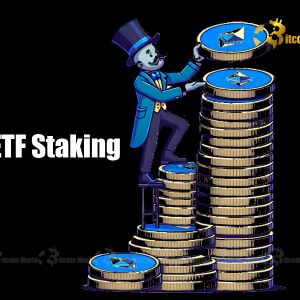Ethereum ETF Staking: SEC’s Crucial Delay Fuels Market Uncertainty
6 min read
BitcoinWorld Ethereum ETF Staking: SEC’s Crucial Delay Fuels Market Uncertainty The cryptocurrency world holds its breath as the U.S. Securities and Exchange Commission (SEC) once again hits the pause button on a pivotal decision. This time, it’s the highly anticipated Bitwise proposal to include staking in its spot Ethereum ETF , a move that could reshape how investors access the second-largest digital asset. The news, initially reported by @PhoenixNewsIO on X, highlights the regulatory body’s cautious approach, which also saw a postponement for the 21Shares spot Dogecoin ETF. What does this mean for the future of crypto investments, and why is the SEC taking its time? What’s the Latest on the Ethereum ETF Staking Proposal? For months, the crypto community has been buzzing with anticipation surrounding the approval of spot Ethereum Exchange-Traded Funds. Following the landmark approval of spot Bitcoin ETFs earlier this year, many believed Ethereum would be next in line. However, the path for Ethereum appears to be fraught with additional complexities, primarily due to its transition to a Proof-of-Stake (PoS) consensus mechanism and the integrated concept of staking. Bitwise, a prominent asset manager, submitted a unique proposal that sought to incorporate a staking component into its spot Ethereum ETF. This means that, if approved, the ETF would not only hold physical Ethereum but also stake a portion of it to earn yield, potentially passing those returns on to investors. This innovative approach aims to offer a more comprehensive exposure to Ethereum’s ecosystem. The SEC’s latest move, a delay in its decision, indicates a need for more time to thoroughly review the implications of such a structure. Why is the SEC Decision Taking So Long? The SEC’s prolonged deliberation on the Bitwise Ethereum ETF with staking is not entirely unexpected. The agency operates under a mandate to protect investors and maintain fair, orderly, and efficient markets. When it comes to novel financial products like crypto ETFs, especially those involving staking, the SEC faces several unique challenges and concerns: Investor Protection: The SEC scrutinizes whether investors fully understand the risks associated with staking, including smart contract vulnerabilities, slashing penalties, and the illiquidity of staked assets. Market Manipulation: Concerns persist about the potential for manipulation in the underlying spot markets for cryptocurrencies, even with Ethereum’s significant market capitalization. Custody and Security: Staking introduces additional layers of complexity regarding the custody of assets and the security protocols required to protect staked ETH. Classification of Staking: A fundamental question for the SEC is whether staking rewards or the act of staking itself constitutes a security offering under U.S. law, which would bring it under a different regulatory framework. The approval process for a spot Bitcoin ETF was relatively straightforward in comparison, as Bitcoin operates on a Proof-of-Work (PoW) mechanism without staking. The transition of Ethereum to PoS adds a new dimension that the SEC must carefully evaluate. Key Differences: Bitcoin vs. Ethereum ETF Approval Process Feature Bitcoin Spot ETF Ethereum Spot ETF (with Staking) Consensus Mechanism Proof-of-Work (PoW) Proof-of-Stake (PoS) Yield Generation No inherent yield generation Staking offers yield Regulatory Complexity Primarily market manipulation concerns Market manipulation, staking classification, custody of staked assets Precedent Grayscale court ruling was pivotal New territory for staking within ETFs Broader Implications for the Crypto ETF Landscape The SEC’s cautious stance extends beyond Ethereum. The simultaneous delay of the 21Shares spot Dogecoin ETF application underscores a broader regulatory hesitancy towards a wider range of digital assets. While Bitcoin’s approval created a precedent, it did not open the floodgates for all cryptocurrencies. Each asset and its unique characteristics, particularly its consensus mechanism and associated activities like staking, are subject to individual scrutiny. This ongoing delay for the Crypto ETF applications could mean a slower, more deliberate rollout of diversified crypto investment products in the U.S. It signals that the SEC is not simply rubber-stamping applications but is taking a measured approach to ensure regulatory clarity and investor protection in a rapidly evolving market. Diving Deeper into the Bitwise Ethereum Proposal Bitwise Asset Management has been a proactive player in the crypto ETF space, being one of the first to file for a spot Bitcoin ETF and now pushing the boundaries with its Ethereum staking proposal. Their strategy is to offer investors not just exposure to the price movements of ETH but also the potential to earn passive income through staking rewards, mirroring the benefits of directly holding and staking Ethereum. The inclusion of staking in an ETF product presents significant operational and regulatory hurdles. How would the staking rewards be managed? What are the tax implications for investors? How would the ETF ensure liquidity for redemptions if a significant portion of its ETH is locked up in staking? These are complex questions that Bitwise and the SEC are likely grappling with during this review period. The success of the Bitwise Ethereum ETF with staking could set a crucial precedent for future yield-bearing crypto products in the traditional finance world. The Complexities of ETH Staking and Regulatory Scrutiny ETH staking is a fundamental aspect of Ethereum’s post-Merge network. It involves locking up ETH to support the network’s security and operations, for which participants earn rewards. While attractive for its passive income potential, integrating staking into a regulated ETF product introduces several layers of complexity: Benefits of Staking for Investors (if integrated into an ETF): Passive Income: Potential to earn yield on ETH holdings, enhancing overall returns. Network Security: Contributing to the stability and security of the Ethereum network. Accessibility: An ETF could make staking accessible to traditional investors without the technical complexities of self-staking. Challenges for ETFs Incorporating Staking: Liquidity: Staked ETH is typically locked for periods, impacting the ETF’s ability to meet redemptions. Slashing Risk: Penalties for validators’ misbehavior could lead to loss of staked ETH. Centralization Concerns: Large institutional stakers could raise concerns about network decentralization. Regulatory Classification: The ongoing debate whether staking rewards constitute unregistered securities. The SEC’s decision will likely hinge on how these challenges are addressed and whether the proposed structure adequately protects investors from the unique risks associated with ETH staking within a regulated product. Market Reaction and Future Outlook The market’s reaction to the latest delay has been relatively muted, as such postponements have become a common occurrence in the crypto ETF approval saga. However, the underlying sentiment remains one of cautious optimism. Analysts generally anticipate that spot Ethereum ETFs will eventually gain approval, though the timeline for those including staking remains highly uncertain. Many experts point to May 2024 as a critical window for a final SEC decision on several spot Ethereum ETF applications, including those from VanEck and Ark Invest/21Shares, though these do not currently include staking. The Bitwise proposal with staking adds another layer of complexity that might require more time. Investors should brace for continued volatility and further delays as the SEC navigates this uncharted regulatory territory. Actionable Insights for Crypto Enthusiasts While the wait for a spot Ethereum ETF with staking continues, here are some actionable insights for those interested in the crypto market: Stay Informed: Keep a close eye on SEC filings and announcements from asset managers. Regulatory developments are key drivers of market sentiment. Understand the Nuances: Differentiate between pure spot ETFs and those with staking components. Each carries different risk profiles and potential benefits. Consider Direct Staking (with caution): For those comfortable with the technical aspects and risks, direct ETH staking remains an option, but understand the implications of locking up your assets. Diversify Your Portfolio: Don’t place all your investment hopes on a single regulatory approval. The crypto market offers a vast array of opportunities. A Glimpse into Tomorrow: The Evolving Crypto Landscape The SEC’s decision to delay the Bitwise Ethereum ETF staking proposal is a reminder that the integration of cryptocurrencies into traditional finance is a gradual, complex process. While frustrating for some, these delays underscore the regulatory body’s commitment to due diligence in a nascent yet rapidly maturing asset class. The eventual approval of such products, especially those incorporating yield-generating mechanisms like staking, would mark a significant milestone, opening doors for broader institutional and retail adoption. The journey towards fully regulated and innovative crypto investment vehicles continues, characterized by a delicate dance between technological advancement and regulatory prudence. The crypto market remains dynamic, promising both challenges and immense opportunities for those who stay informed and adaptable. To learn more about the latest Ethereum trends, explore our article on key developments shaping Ethereum institutional adoption . This post Ethereum ETF Staking: SEC’s Crucial Delay Fuels Market Uncertainty first appeared on BitcoinWorld and is written by Editorial Team

Source: Bitcoin World



